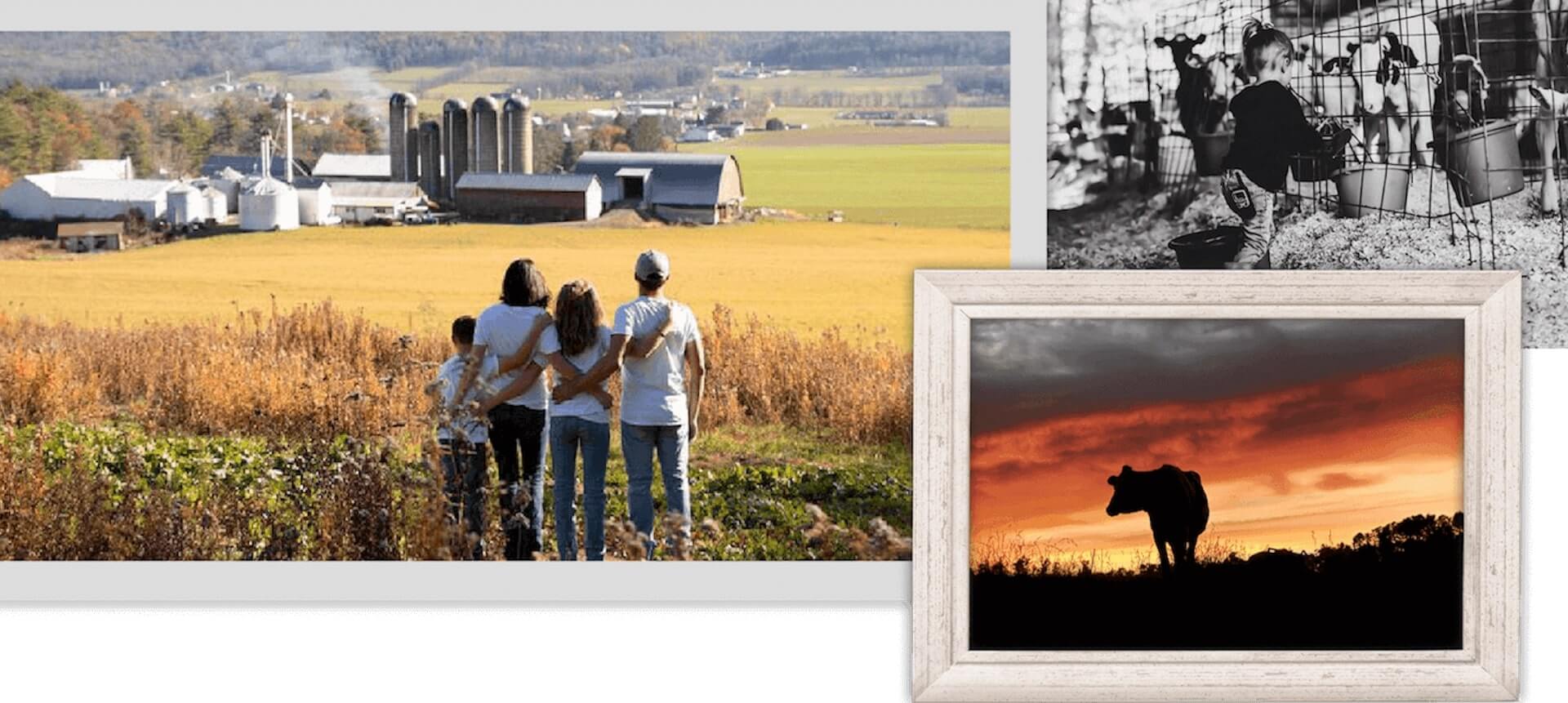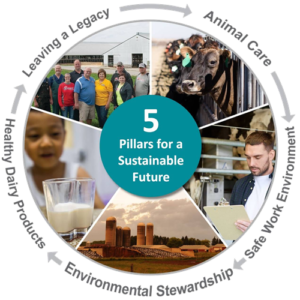
Articles
Animal Welfare: Consumers’ No. 1 Priority
Today’s consumers want to know the nitty-gritty everyday details about the animals that contribute to the food on their table. In fact, according to the 2016 Consumer Trust Research Report from the Center for Food Integrity, 80% of consumers surveyed said they have an interest in knowing more. But, it’s not just an interest in knowing more about how food is produced that’s driving today’s consumer. This increased interest spans all aspects of food production—social, economic and ecological—and animal welfare frequently tops the list of concerns.
The dairy industry is constantly under scrutiny, and today’s consumers have plenty of questions. That’s why it’s imperative you join us by taking the Real Faces of Dairy Pledge. The first pillar in the pledge focuses on how we care for our animals. Step up and show today’s consumers how animal welfare is an integral part of life on a dairy farm. Without an inside look into what’s really happening on a dairy, consumers will develop their own opinions based on the resources they can find.
Identifying consumer concerns
Understanding consumer values is critical as we all work to further develop sustainable food-animal agriculture. A 2016 Journal of Dairy Science publication from the University of British Columbia, titled “Imagining the Ideal Dairy Farm,” reports that the top concerns raised by 493 U.S. citizens who responded to the survey were in regards to “wanting assurances that the animals had a reasonable quality of life and the indirect effect of animal welfare on milk quality.”
I think that the better the cows are taken care of, and the healthier they are, the healthier the milk will be,” said one respondent in the study.
The article also states that those who took part in the study believe the well-being of the dairy animals was above all other consideration—and that to have a good life cows should be provided access to pasture. Additionally, a few respondents commented on the fact that this includes not separating a newborn from its mother, as well.
These citizens described the ideal dairy to be a modern, profitable dairy farm that houses cows in a clean environment because that means they’re healthier. And if the cows are healthier, well, of course the milk is, too.
A well-known industry expert on animal welfare and the lead scientist involved in the Ideal Dairy Farm survey, Dr. Marina von Keyserlingk, describes animal welfare as addressing three types of concern: Is the animal healthy and functioning well; is the animal feeling well; and is the animal able to live a reasonably natural life.
“Producers are usually concerned with the biological care of the animal, typically focusing on disease, injury, growth rates and reproductive problems. Consumers on the other hand tend to be more concerned with the animal’s emotions and whether or not the animal lives a relatively natural life,” von Keyserlingk says.
Telling your story
Providing access to pasture and providing a good life for dairy cows top the list of consumer concerns when asked about their views on the dairy industry. So, how do you go about telling your dairy story to consumers when you know you’ve got those hurdles to clear first? 
“You start by taking pride and ownership of the things you’re doing on your farm,” says Jessica Ziehm, a dairy farm wife and executive director of the New York Animal Agriculture Coalition (NYAAC).
In her work with NYAAC, Ziehm works to enhance the public’s understanding and appreciation for animal agriculture, particularly modern dairy farms as more than 50% of the state’s agricultural receipts come from the industry.
A self-professed coach for dairy farmers, Ziehm says consumers want to get their information from farmers directly because they desire authenticity. “Dairy farmers are still considered a valued and trustworthy source of information, and the messages delivered by dairy farmers themselves are received as truthful,” Ziehm says.
Farm newsletters are one way NYAAC helps producers share their story with consumers. “What happens on my farm happens on any farm in America,” she says. “That allows me to write all the articles for the newsletters. I then let the farmers choose and edit the articles to fit their operation, and add some pictures from their farm to personalize the newsletter. I’m basically doing all the legwork to help make the process easy for them.”
The project has been an easy, effective way to help farmers tell their story that fits most farms’ budgets. Best of all, it’s a personalized and local message.
Ziehm also instituted a birthing center at the New York State Fair four years ago to help tell dairy’s story. The message is conveyed with the help of 300 to 350 dairy-industry volunteers. Consumers visit the center to witness a calf being born but end up staying for hours talking with industry volunteers, she says.
“The No. 1 question we get at the birthing center is why do you separate the cow and the calf,” Ziehm says. She has worked hard to help dairy farmers understand the importance of telling dairy’s story exactly like it happens at home on the farm. “There is a reason why we are doing the things we are doing,” she says. “At the birthing center, we’re creating the opportunity to talk about these things and to show people that it’s okay.”
While consumers don’t always like the cow-calf separation, Ziehm says the value is in recognizing the tough issues and being willing to talk about them.
Antibiotic use, GMOs (genetically modified organisms) and freestall housing are other examples of farm management tools that Ziehm says producers need to be able to explain.
“If we want to continue to be able to administer antibiotics to our animals, we need to talk about why it’s important to treat animals when they’re sick,” Ziehm says. “It’s no different than why I give antibiotics to my own children when they are sick.”
Taking the first steps
Connecting with consumers is as simple as opening the door of your farm to neighbors, and small farm tours are a great way to share your dairy story.
“Our next-door neighbors sometimes have the least amount of information about our industry,” Ziehm says. “I think that audience is sometimes overlooked as they are so close to us. Clear and frequent communication with our neighbors and members of our community could help turn them into our allies, rather than our enemies.”
“Listening and learning what concerns the public is key for producers when it comes to sharing their dairy story,” von Keyserlingk says. By applying an adaptive transparency policy you can develop a game plan for addressing consumer concerns. von Keyserlingk also encourages dairy farmers to keep a list of the most frequently asked questions raised by those who visit their farm and then adapting their story to make sure that they answer these specific concerns.
Sharing your dairy story also means practicing self-reflection. Not everything is squeaky clean on a dairy farm all the time, Ziehm says. “So being able to admit when we are wrong or when something is challenging is equally important in being an effective advocate. That truthfulness makes us real.”
While any open door is a good tour, von Keyserlingk also says it’s imperative for producers to think outside the box to continually try to better manage their operations. The public wants assurances and “the life of the cow is first and foremost,” she says.
It’s human nature for people to want to know about other people. So, Ziehm also encourages producers to talk about their families. “Talk about your children,” Ziehm says. “Talk about your grandparents or a newborn calf. These emotional components of dairy farming are an excellent way to put a face on issues and our industry, and make us more relatable and likable with the public. They can also help take the edge off a conversation about heavy-hitting issues that are strictly science and fact driven.”
A true believer that dairy farming requires a social license, Ziehm realizes consumers are dictating a lot more about what is taking place on the farm. Connecting with them and supporting growth in our industry starts right at home.
“Farming will be much more enjoyable and sustainable in the future if we have neighbors and consumers that trust us.”



